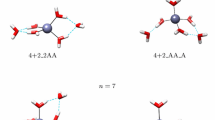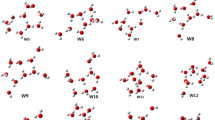Abstract
Global search on small hydrated zinc(II) clusters [Zn2+(H2O)n (n = 1–8)] is executed based on comprehensive genetic algorithm with density functional theory. The subsequent high level ab initio calculation provides accurate structures, energies and spectroscopic properties of the clusters. For n ≤ 6, all the water molecules are coordinated waters in global minima, while two five-coordinated structures possesses the lowest energies for n = 7 and 8 at 0 K. Besides, the four-coordinated structures could equally populate with the global minima above room temperature for n = 5 and 6. Furthermore, the infrared (IR) spectra with anharmonic correction could reproduce the experimental spectra quite well, and effectively discriminate the isomers in experiment, which might be selected by the energetic driving of water-loss reaction.





Similar content being viewed by others
References
M. F. Hochella, S. K. Lower, P. A. Maurice, R. L. Penn, N. Sahai, D. L. Sparks, and B. S. Twining (2008). Nanominerals, Mineral Nanoparticles, and Earth Systems. Science 319, 1631–1635.
C. W. Bock, A. K. Katz, and J. P. Glusker (1995). Hydration of Zinc Ions: A Comparison with Magnesium and Beryllium Ions. J. Am. Chem. Soc. 117, 3754–3765.
M. Hartmann, T. Clark and R. van Eldik, in Theoretical Study of the Water Exchange Reaction on Divalent Zinc Ion Using Density Functional Theory, Molecular modeling annual (Springer, 1996), pp. 354–357.
M. Pavlov, P. E. Siegbahn, and M. Sandström (1998). Hydration of Beryllium, Magnesium, Calcium, and Zinc Ions Using Density Functional Theory. J. Phys. Chem. A 102, 219–228.
S. Lee, J. Kim, J. K. Park, and K. S. Kim (1996). Ab Initio Study of the Structures, Energetics, and Spectra of Aquazinc (ii). J. Phys. Chem. 100, 14329–14338.
M. Hartmann, T. Clark, and R. van Eldik (1997). Hydration and Water Exchange of Zinc (ii) Ions. Application of Density Functional Theory. J. Am. Chem. Soc. 119, 7843–7850.
W. W. Rudolph and C. C. Pye (1999). Zinc (ii) Hydration in Aqueous Solution. A Raman Spectroscopic Investigation and an Ab-Initio Molecular Orbital Study. Phys. Chem. Chem. Phys. 1, 4583–4593.
S. De, S. M. Ali, A. Ali, and V. Gaikar (2009). Micro-Solvation of the Zn2+ Ion—a Case Study. Phys. Chem. Chem. Phys. 11, 8285–8294.
T. E. Cooper, D. Carl, and P. Armentrout (2009). Hydration Energies of Zinc (ii): Threshold Collision-Induced Dissociation Experiments and Theoretical Studies. J. Phys. Chem. A 113, 13727–13741.
T. E. Cooper, J. T. O’Brien, E. R. Williams, and P. Armentrout (2010). Zn2+ Has a Primary Hydration Sphere of Five: Ir Action Spectroscopy and Theoretical Studies of Hydrated Zn2+ Complexes in the Gas Phase. J. Phys. Chem. A 114, 12646–12655.
J. C. Wu, J. P. Piquemal, R. Chaudret, P. Reinhardt, and P. Ren (2010). Polarizable Molecular Dynamics Simulation of Zn (ii) in Water Using the Amoeba Force Field. J. Chem. Theory Comput. 6, 2059–2070.
T. Zhu, X. Xiao, C. Ji, and J. Z. Zhang (2013). A New Quantum Calibrated Force Field for Zinc-Protein Complex. J. Chem. Theory Comput. 9, 1788–1798.
S. Obst and H. Bradaczek (1997). Molecular Dynamics Simulations of Zinc Ions in Water Using Charmm. J. Mol. Model. 3, 224–232.
G. Del Frate and A. Nikitin (2018). Including Electronic Screening in Classical Force Field of Zinc Ion for Biomolecular Simulations. ChemistrySelect 3, 12367–12370.
G. Chillemi, P. D’Angelo, N. V. Pavel, N. Sanna, and V. Barone (2002). Development and Validation of an Integrated Computational Approach for the Study of Ionic Species in Solution by Means of Effective Two-Body Potentials. The Case of Zn2+, Ni2+, and Co2+ in Aqueous Solutions. J. Am. Chem. Soc. 124, 1968–1976.
A. Kuzmin, S. Obst, and J. Purans (1997). X-Ray Absorption Spectroscopy and Molecular Dynamics Studies of Hydration in Aqueous Solutions. J. Phys.: Condens. Mat. 9, 10065.
E. Cauët, S. Bogatko, J. H. Weare, J. L. Fulton, G. K. Schenter, and E. J. Bylaska (2010). Structure and Dynamics of the Hydration Shells of the Zn2+ Ion from Ab Initio Molecular Dynamics and Combined Ab Initio and Classical Molecular Dynamics Simulations. J. Chem. Phys. 132, 194502.
A. M. Mohammed, H. H. Loeffler, Y. Inada, K. I. Tanada, and S. Funahashi (2005). Quantum Mechanical/Molecular Mechanical Molecular Dynamic Simulation of Zinc (ii) Ion in Water. J. Mol. Liq. 119, 55–62.
X. Liu, X. Lu, R. Wang, and E. J. Meijer (2011). Understanding Hydration of Zn2+ in Hydrothermal Fluids with Ab Initio Molecular Dynamics. Phys. Chem. Chem. Phys. 13, 13305–13309.
M. Ducher, F. Pietrucci, E. Balan, G. Ferlat, L. Paulatto, and M. Blanchard (2017). Van Der Waals Contribution to the Relative Stability of Aqueous Zn2+ Coordination States. J. Chem. Theory Comput. 13, 3340–3347.
M. Xu, T. Zhu, and J. Z. Zhang (2019). Molecular Dynamics Simulation of Zinc Ion in Water with an Ab Initio Based Neural Network Potential. J. Phys. Chem. A 123, 6587–6595.
C. Jana, G. Ohanessian, and C. Clavaguéra (2016). Theoretical Insight into the Coordination Number of Hydrated Mathrm Zn2+ from Gas Phase to Solution. Theor. Chem. Acc. 135, 1–13.
A. Musinu, G. Paschina, G. Piccaluga, and M. Magini (1982). The Sulphate Ion in Aqueous Solution: An X-Ray Diffraction Study of a ZnSO4 Solution. J. Appl. Crystallogr. 15, 621–625.
R. Caminiti, P. Cucca, M. Monduzzi, G. Saba, and G. Crisponi (1984). Divalent Metal-Acetate Complexes in Concentrated Aqueous Solutions. An X-Ray Diffraction and Nmr Spectroscopy Study. J. Chem. Phys. 81, 543–551.
S. P. Dagnall, D. N. Hague, and A. D. Towl (1978). X-Ray Diffraction Study of Aqueous Zinc (ii) Nitrate. J. Chem. Soc., Faraday Trans. 2 (78), 2161–2167.
A. Munoz-Paez, R. R. Pappalardo, and E. Sanchez Marcos (1995). Determination of the Second Hydration Shell of Cr3+ and Zn2+ in Aqueous Solutions by Extended X-Ray Absorption Fine Structure. J. Am. Chem. Soc. 117, 11710–11720.
T. Miyanaga, I. Watanabe, and S. Ikeda (1988). Amplitude in Exafs and Ligand Exchange Reaction of Hydrated 3d Transition Metal Complexes. Chem. Lett. 17, 1073–1076.
K. Ozutsumi, T. Yamaguchi, H. Ohtaki, K. Tohji, and Y. Udagawa (1985). Structure of Ni (ii)–and Zn (ii)–Glycinato Complexes in Aqueous Solution Determined by Exafs Spectroscopy. B. Chem. Soc. Jap. 58, 2786–2792.
Y. Inada, K. Sugimoto, K. Ozutsumi, and S. Funahashi (1994). Solvation Structures of Manganese (ii), Iron (ii), Cobalt (ii), Nickel (ii), Copper (ii), Zinc (ii), Cadmium (ii), and Indium (ii) Ions in 1, 1, 3, 3-Tetramethylurea as Studied by Exafs and Electronic Spectroscopy. Variation of Coordination Number. Inorg. Chem. 33, 1875–1880.
P. D’Angelo, M. Benfatto, S. Della Longa, and N. Pavel (2002). Combined Xanes and Exafs Analysis of Co2+, Ni2+, and Zn2+ Aqueous Solutions. Phys. Rev. B 66, 064209.
P. D’Angelo, V. Barone, G. Chillemi, N. Sanna, W. Meyer-Klaucke, and N. V. Pavel (2002). Hydrogen and Higher Shell Contributions in Zn2+, Ni2+, and Co2+ Aqueous Solutions: An X-Ray Absorption Fine Structure and Molecular Dynamics Study. J. Am. Chem. Soc. 124, 1958–1967.
F. Stellato, M. Calandra, F. d’Acapito, E. De Santis, G. La Penna, G. Rossi, and S. Morante (2018). Multi-Scale Theoretical Approach to X-Ray Absorption Spectra in Disordered Systems: An Application to the Study of Zn (ii) in Water. Phys. Chem. Chem. Phys. 20, 24775–24782.
V. Migliorati, A. Zitolo, G. Chillemi, and P. D’Angelo (2012). Influence of the Second Coordination Shell on the Xanes Spectra of the Zn2+ Ion in Water and Methanol. ChemPlusChem 77, 234–239.
A. A. Shvartsburg and K. M. Siu (2001). Is There a Minimum Size for Aqueous Doubly Charged Metal Cations? J. Am. Chem. Soc. 123, 10071–10075.
A. T. Blades, P. Jayaweera, M. G. Ikonomou, and P. Kebarle (1990). Ion-Molecule Clusters Involving Doubly Charged Metal Ions (M2+). Int. J. Mass Spectrom. 102, 251–267.
T. E. Cooper and P. Armentrout (2009). Experimental and Theoretical Investigation of the Charge-Separation Energies of Hydrated Zinc (ii): Redefinition of the Critical Size. J. Phys. Chem. A 113, 13742–13751.
J. T. O’Brien and E. R. Williams (2011). Coordination Numbers of Hydrated Divalent Transition Metal Ions Investigated with Irpd Spectroscopy. J. Phys. Chem. A 115, 14612–14619.
B. Bandyopadhyay, K. N. Reishus, and M. A. Duncan (2013). Infrared Spectroscopy of Solvation in Small Zn+(H2O)n Complexes. J. Phys. Chem. A 117, 7794–7803.
K. Müller-Dethlefs and P. Hobza (2000). Noncovalent Interactions: A Challenge for Experiment and Theory. Chem. Rev. 100, 143–168.
D. J. Miller and J. M. Lisy (2008). Entropic Effects on Hydrated Alkali-Metal Cations: Infrared Spectroscopy and Ab Initio Calculations of M+(H2O)X= 2–5 Cluster Ions for M= Li, Na, K, and Cs. J. Am. Chem. Soc. 130, 15393–15404.
R. Shi, P. Wang, L. Tang, X. Huang, Y. Chen, Y. Su, and J. Zhao (2018). Structures and Spectroscopic Properties of F–(H2O)N with N= 1–10 Clusters from a Global Search Based on Density Functional Theory. J. Phys. Chem. A 122, 3413–3422.
J. J. Fifen and N. Agmon (2016). Structure and Spectroscopy of Hydrated Sodium Ions at Different Temperatures and the Cluster Stability Rules. J. Chem. Theory Comput. 12, 1656–1673.
J. Zhao, R. Shi, L. Sai, X. Huang, and Y. Su (2016). Comprehensive Genetic Algorithm for Ab Initio Global Optimisation of Clusters. Mol. Simulat. 42, 809–819.
A. D. Becke (1988). Density-Functional Exchange-Energy Approximation with Correct Asymptotic Behavior. Phys. Rev. A 38, 3098.
C. Lee, W. Yang, and R. G. Parr (1988). Development of the Colle-Salvetti Correlation-Energy Formula into a Functional of the Electron Density. Phys. Rev. B 37, 785.
B. Delley (2000). From Molecules to Solids with the Dmol 3 Approach. J. Chem. Phys. 113, 7756–7764.
P. Wang, R. Shi, Y. Su, L. Tang, X. Huang, and J. Zhao (2019). Hydrated Sodium Ion Clusters [Na+(H2O)N (N= 1–6)]: An Ab Initio Study on Structures and Non-Covalent Interaction. Front. Chem. 7, 624.
C. Møller and M. S. Plesset (1934). Note on an Approximation Treatment for Many-Electron Systems. Phys. Rev. 46, 618.
Y. Liu, J. Zhao, F. Li, and Z. Chen (2013). Appropriate Description of Intermolecular Interactions in the Methane Hydrates: An Assessment of Dft Methods. J. Comput. Chem. 34, 121–131.
R. Shi, X. Huang, Y. Su, H. G. Lu, S. D. Li, L. Tang, and J. Zhao (2017). Which Density Functional Should Be Used to Describe Protonated Water Clusters? J. Phys. Chem. A 121, 3117–3127.
T. H. Dunning (1989). Gaussian-Basis Sets for Use in Correlated Molecular Calculations. 1. The Atoms Boron through Neon and Hydrogen. J. Chem. Phys. 90, 1007–1023.
R. A. Kendall, T. H. Dunning Jr., and R. J. Harrison (1992). Electron Affinities of the First-Row Atoms Revisited. Systematic Basis Sets and Wave Functions. J. Chem. Phys. 96, 6796–6806.
V. Barone (2005). Anharmonic Vibrational Properties by a Fully Automated Second-Order Perturbative Approach. J. Chem. Phys. 122, 014108.
V. Barone, J. Bloino, C. A. Guido, and F. Lipparini (2010). A Fully Automated Implementation of Vpt2 Infrared Intensities. Chem. Phys. Lett. 496, 157–161.
M. Frisch, G. Trucks, H. Schlegel, G. Scuseria, M. Robb, J. Cheeseman, G. Scalmani, V. Barone, G. Petersson, and H. Nakatsuji, Gaussian 16, Revision A. 03 (Gaussian Inc, Wallingford Ct. City, 2016).
Acknowledgements
This work was supported by the National Natural Science Foundation of China (11674046, 91961204 and 12004095), Scientific and Technological Research in Higher Education Institutions of Hebei Province (BJK2022057), Handan Science and Technology Bureau (21422901248), and the Supercomputing Center of Dalian University of Technology, Shanghai Supercomputer Center.
Author information
Authors and Affiliations
Corresponding author
Additional information
Publisher's Note
Springer Nature remains neutral with regard to jurisdictional claims in published maps and institutional affiliations.
Supplementary Information
Below is the link to the electronic supplementary material.
Rights and permissions
About this article
Cite this article
Wang, P., Su, Y., Shi, R. et al. Structures and Spectroscopic Properties of Hydrated Zinc(II) Ion Clusters [Zn2+(H2O)n (n = 1−8)] by Ab Initio Study. J Clust Sci 34, 1625–1632 (2023). https://doi.org/10.1007/s10876-022-02277-8
Received:
Accepted:
Published:
Issue Date:
DOI: https://doi.org/10.1007/s10876-022-02277-8




